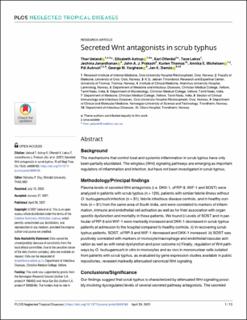| dc.contributor.author | Ueland, Thor | |
| dc.contributor.author | Astrup, Elisabeth | |
| dc.contributor.author | Otterdal, Kari | |
| dc.contributor.author | Lekva, Tove | |
| dc.contributor.author | Janardhanan, Jeshina | |
| dc.contributor.author | Prakash, John A. | |
| dc.contributor.author | Thomas, Kurien | |
| dc.contributor.author | Michelsen, Annika | |
| dc.contributor.author | Aukrust, Pål | |
| dc.contributor.author | Varghese, George M. | |
| dc.contributor.author | Damås, Jan Kristian | |
| dc.date.accessioned | 2021-07-13T08:02:42Z | |
| dc.date.available | 2021-07-13T08:02:42Z | |
| dc.date.created | 2021-06-23T12:31:32Z | |
| dc.date.issued | 2021 | |
| dc.identifier.citation | PLoS Neglected Tropical Diseases. 2021, 15 (4), . | en_US |
| dc.identifier.issn | 1935-2727 | |
| dc.identifier.uri | https://hdl.handle.net/11250/2764234 | |
| dc.description.abstract | Background The mechanisms that control local and systemic inflammation in scrub typhus have only been partially elucidated. The wingless (Wnt) signaling pathways are emerging as important regulators of inflammation and infection, but have not been investigated in scrub typhus. Methodology/Principal findings Plasma levels of secreted Wnt antagonists (i.e. DKK-1, sFRP-3, WIF-1 and SOST) were analyzed in patients with scrub typhus (n = 129), patients with similar febrile illness without O. tsutsugamushi infection (n = 31), febrile infectious disease controls, and in healthy controls (n = 31) from the same area of South India, and were correlated to markers of inflammation, immune and endothelial cell activation as well as for their association with organ specific dysfunction and mortality in these patients. We found i) Levels of SOST and in particular sFRP-3 and WIF-1 were markedly increased and DKK-1 decreased in scrub typhus patients at admission to the hospital compared to healthy controls. ii) In recovering scrub typhus patients, SOST, sFRP-3 and WIF-1 decreased and DKK-1 increased. iii) SOST was positively correlated with markers of monocyte/macrophage and endothelial/vascular activation as well as with renal dysfunction and poor outcome iv) Finally, regulation of Wnt pathways by O. tsutsugamushi in vitro in monocytes and ex vivo in mononuclear cells isolated from patients with scrub typhus, as evaluated by gene expression studies available in public repositories, revealed markedly attenuated canonical Wnt signaling. Conclusions/Significance Our findings suggest that scrub typhus is characterized by attenuated Wnt signaling possibly involving dysregulated levels of several secreted pathway antagonists. The secreted Wnt antagonist SOST was strongly associated with renal dysfunction and poor prognosis in these patients. | en_US |
| dc.language.iso | eng | en_US |
| dc.publisher | Public Library of Science, PLOS | en_US |
| dc.rights | Navngivelse 4.0 Internasjonal | * |
| dc.rights.uri | http://creativecommons.org/licenses/by/4.0/deed.no | * |
| dc.title | Secreted wnt antagonists in scrub typhus | en_US |
| dc.type | Peer reviewed | en_US |
| dc.type | Journal article | en_US |
| dc.description.version | publishedVersion | en_US |
| dc.source.volume | 15 | en_US |
| dc.source.journal | PLoS Neglected Tropical Diseases | en_US |
| dc.source.issue | 4 | en_US |
| dc.identifier.doi | 10.1371/journal.pntd.0009185 | |
| dc.identifier.cristin | 1917912 | |
| dc.description.localcode | Copyright: © 2021 Ueland et al. This is an open access article distributed under the terms of the Creative Commons Attribution License, which permits unrestricted use, distribution, and reproduction in any medium, provided the original author and source are credited. | en_US |
| dc.source.articlenumber | e0009185 | en_US |
| cristin.ispublished | true | |
| cristin.fulltext | original | |
| cristin.qualitycode | 1 | |

